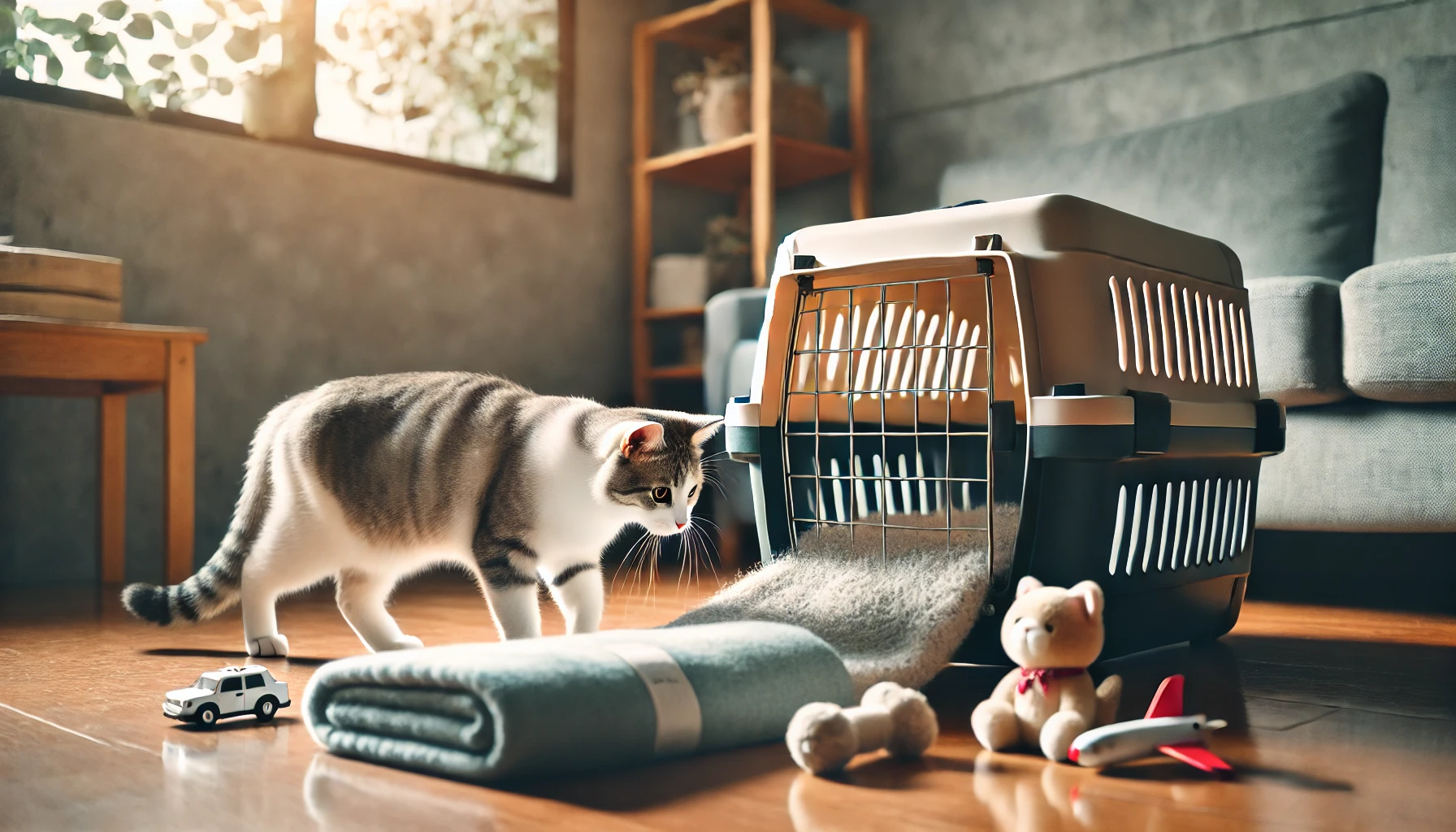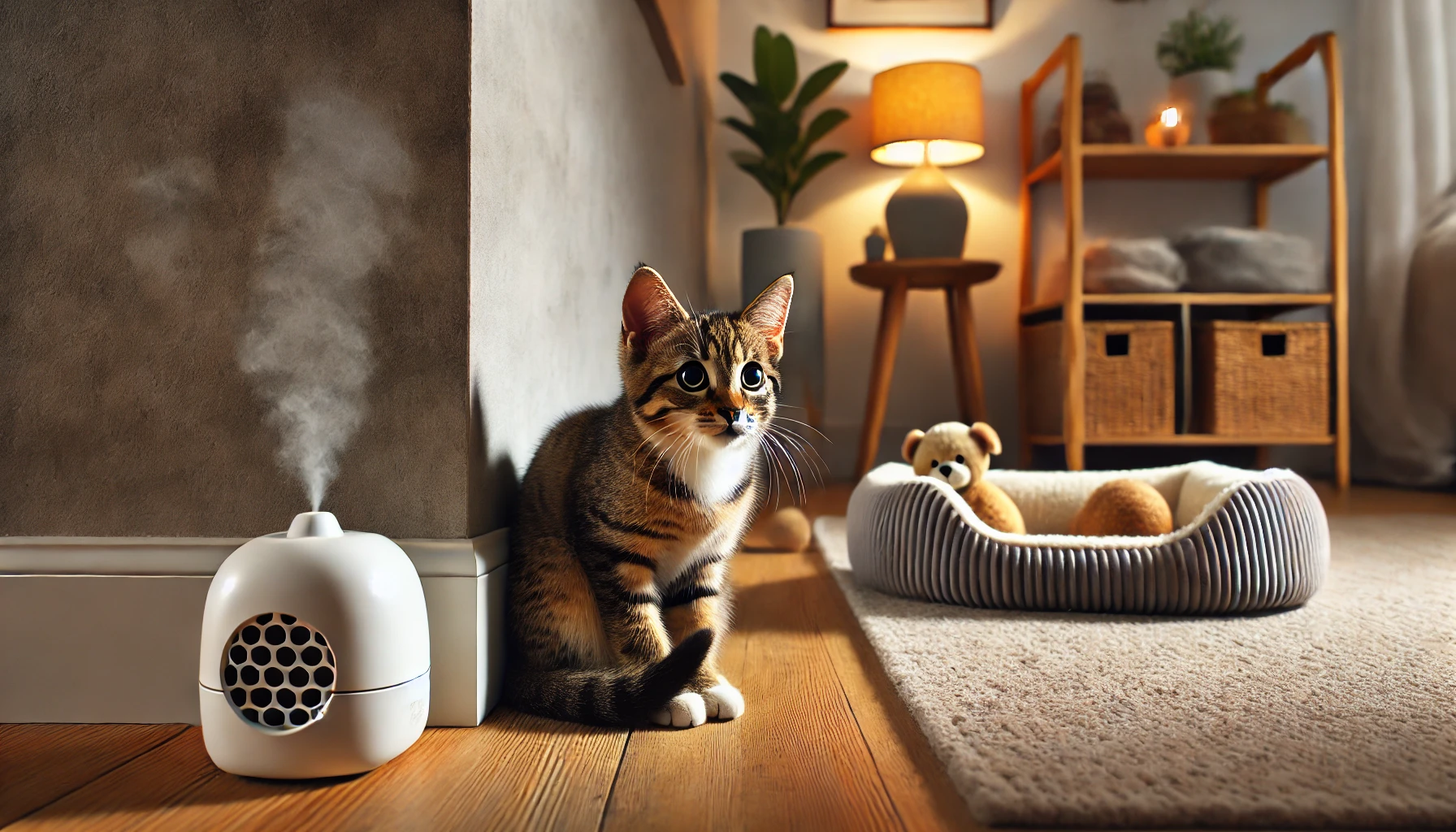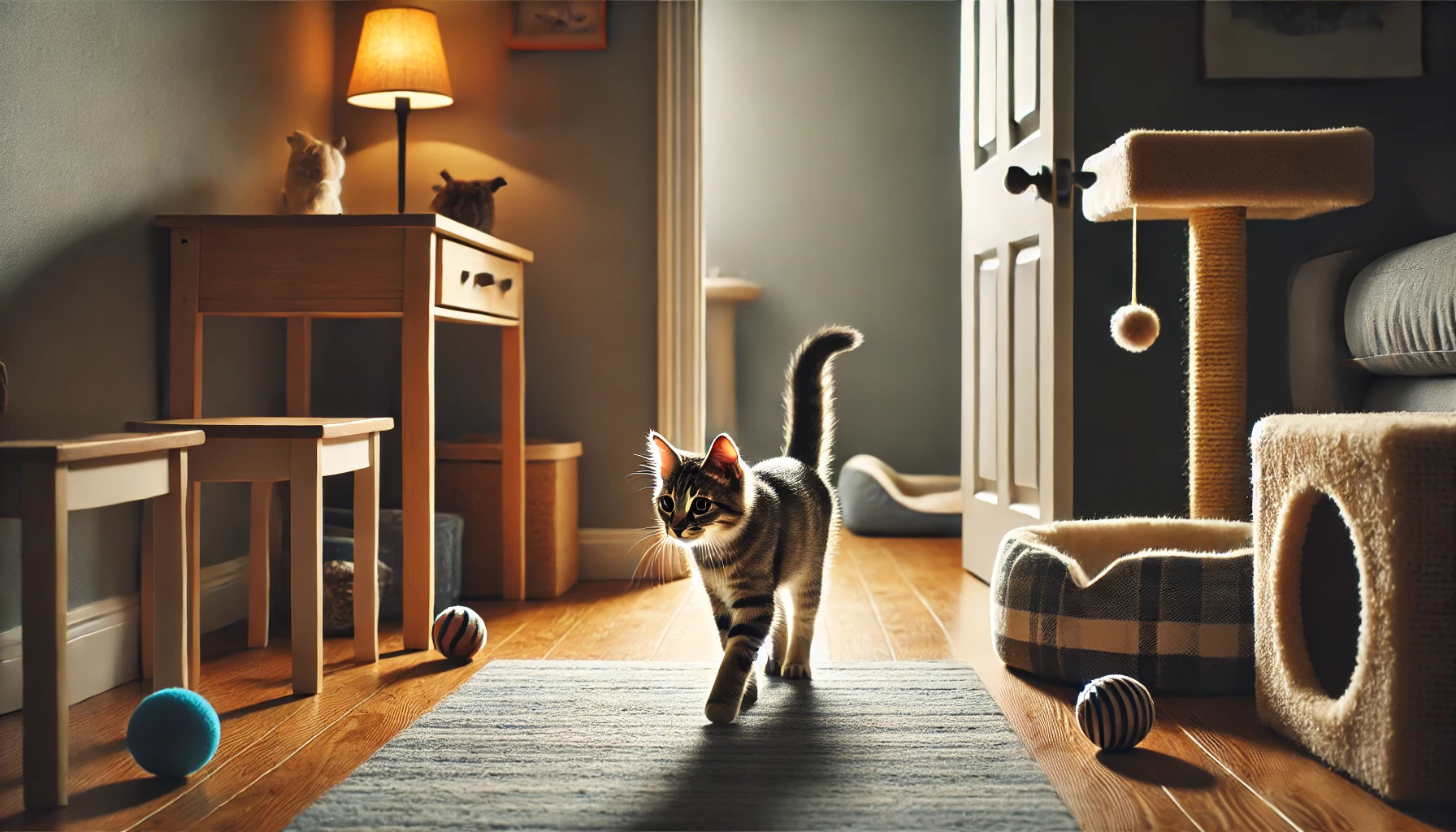How to Introduce Cats to New Environments

Bringing your cat into a new environment can be quite an exciting but challenging time.
Cats are naturally territorial and cling to the familiar surroundings they know.
Putting them in a completely new location creates stress, anxiety, and confusion.
Whether you’re moving into a new home or taking your cat on a trip, the key is to ensure that this change of environment is done as smoothly and comfortably as possible.
This guide will help you find the best method of introducing your cat to new environments while keeping their well-being in mind.
The better the preparation and the more thoughtful your decisions, the easier it is to help your furry friend transition into any new surroundings.
Table of Contents
Preparing Your Cat for New Environments
It is important to prepare your cat well in advance before introducing them to the new environment.
Preparation means understanding your cat’s personality, selecting the right travel gear, and letting them get used to essential items.
This helps reduce anxiety and makes the introduction process easier for both you and your cat.

Assessing Your Cat’s Personality
Just like people, every cat is different and reacts uniquely to a change of environment.
Some cats are curious and adventurous, while others may be more reserved and cautious.
First, observe your cat in their familiar surroundings.
Do they quickly adapt to changes, or do they hide and later show signs of stress when something unfamiliar happens?
Understanding these traits will help you determine how much preparation and care your cat will need during the transition.
If your cat is laid-back, curious, and easy-going, they may adapt more easily to new environments.
However, if your cat is nervous or skittish, you may need to take extra steps to ensure they feel comfortable and secure.
No matter the personality, all cats require time and patience to get used to changes in their surroundings.
Selecting the Proper Travel Gear
Preparing your cat for a new environment involves choosing the right travel gear.
A sturdy and comfortable carrier is essential.
Ensure it is well-ventilated, spacious enough for your cat to turn around inside, and has a soft lining for comfort.
For long-distance journeys, consider a carrier with food and water compartments to keep your cat hydrated and fed during travel.
- Get a comfortable and sturdy cat carrier.
- Look for a carrier with good ventilation and padding.
- Ensure enough space for food and water if needed during the journey.
It’s also important to get your cat used to the carrier before travel day.
Let them investigate it, place familiar items like a blanket or toy inside, and encourage them to spend time in it.
This helps associate the carrier with positive experiences, making travel or moving day less stressful.

Familiarizing Cats with Travel Items
You can also familiarize your cat with the items they’ll encounter during the move.
Start by placing their carrier, travel blankets, and other necessary items in their usual living space.
Give them time to explore these items through smell and touch so they can become comfortable around them.
You can even leave the carrier out a few days before moving day so it becomes part of their familiar environment.
By doing this, your cat will feel more comfortable on travel day, as these items will no longer feel foreign to them.
Familiarity plays a key role in reducing stress and making the transition to the new environment as smooth as possible.
Proper preparation will reduce stress for both you and your cat when introducing them to new environments.

Creating a Safe Space in a New Environment
Among the most valuable things you can give your cat when arriving at a new home is a safe space.
This will be a haven where your cat can seek refuge, hide, rest, and orient themselves in the new surroundings.
Cats often prefer quiet, hidden areas, especially when they are surrounded by unfamiliar settings.
When introducing cats to new environments, providing a secure space helps them cope with the stress and anxiety that come with change.

Setting Up a Comfortable Space for Your Cat
Choose the quietest and lowest-traffic area of the house to set up your cat’s new safe space.
This could be a bedroom or small office, as long as it’s an area where your cat won’t be overwhelmed by new sights and smells.
Place familiar items like their bed, favorite toys, and scratching posts in this space.
These will carry their scent and help them feel more relaxed and secure in the new environment.
- Choose a secluded area of the house with less traffic flow for your cat’s safe space.
- Include recognizable items like their bed, favorite toys, and scratching posts.
- The area should be warm, cozy, and inviting.
You can also place their litter box and food bowls in this room for the time being, so they don’t have to roam far to find necessities.
This allows them to become comfortable with the space before gradually exploring the rest of the house.

Introducing Familiar Objects for Comfort
Cats are highly sensitive to smells, and familiar scents can help lower their anxiety.
Bringing items that smell like their old home, such as blankets, bedding, or even unwashed clothes, can provide a source of security.
Additionally, you can use a pheromone spray or diffuser, like Feliway, which mimics natural cat pheromones to calm your cat during stressful transitions.
Allow your cat space and time to explore their new environment without being forced into immediate interaction with new people or pets.
This helps build their confidence in the new surroundings.
- Bring familiar-smelling items like blankets, bedding, and toys.
- Use calming pheromone diffusers or sprays to create a relaxing atmosphere.
- Allow your cat to explore the new environment at their own pace.

Ensuring Safety and Security
After comfort, safety is one of the most essential things you can provide for your cat in a new setting.
Ensure that windows and doors are securely locked to prevent accidents where your cat might accidentally run away.
If you’re in a new home, check for small nooks or crannies where your cat might hide or get stuck.
It’s also advisable to keep hazardous items, such as cleaning supplies and electrical cords, out of reach until your cat becomes fully familiar with the new environment.
Consider using baby gates or closing off certain rooms to limit your cat’s access to areas they may not be ready to explore.
Gradually expanding their territory will help your cat feel more confident and less overwhelmed by the size of the new environment.
- Ensure windows and doors are closed and locked.
- Check for small spaces where your cat could hide or get stuck.
- Keep hazardous materials out of reach.
- Use baby gates or restrict access to certain rooms for safety.
By giving your cat a comfortable place to rest and ensuring their safety, you will help them feel secure and confident as they adjust to their new environment.
Make it a haven for them and allow them to explore at their own pace for a smoother, less stressful transition.
Setting up a secure and quiet space for your cat is crucial to helping them feel safe and comfortable in new surroundings.

Gradual Introduction of Your Cat in Steps
Introducing your cat to a new environment should be done gradually to avoid overwhelming them with stress.
Cats are creatures of routine and can easily become anxious due to changes in their surroundings.
A step-by-step approach allows your cat to explore at their own pace, helping build confidence and reducing negative behaviors such as hiding or aggression.
When introducing cats to new environments, patience is key to ensuring a smooth transition.

Let Your Cat Explore Slowly
If you’re introducing your cat to a new atmosphere, it’s best to let them explore at their own pace.
On the first day, confine your cat to a safe space.
This allows them to become familiar with one part of the new environment without feeling overwhelmed.
As they become more comfortable, gradually introduce your cat to other areas of your home by opening one room at a time.
This slow exposure helps avoid sensory overload and gives your cat confidence as they explore.
Be patient—each cat will adapt at their own pace, with some needing more time than others to become comfortable.
Forcing your cat into new spaces or rushing the process can increase their anxiety rather than calming them down.
- Day 1: Keep your cat confined to a safe area.
- Gradually introduce other parts of the house, one room at a time.
- Let your cat explore at their own pace; never hurry them.

Using Positive Reinforcement
One of the most valuable tools when introducing your cat to new surroundings is positive reinforcement.
Reward your cat with treats, toys, or affection whenever they display calm and confident behavior.
This helps reinforce the idea that their new environment is safe.
Positive reinforcement builds trust between you and your cat, encouraging them to explore their surroundings without fear.
Reward your cat whenever they take a brave step and explore a new area.
This helps create a positive association with the new space, making your cat feel more comfortable over time.
- Give your cat treats or toys to reinforce good, calm behavior.
- Reward them whenever they move into a new space confidently.
- Build trust through positive reinforcement and affection.

Avoid Overstimulation in the First Few Days
During the first few days in a new environment, it’s important to avoid overstimulation.
New sights, smells, and sounds can be overwhelming for your cat, and overstimulation can lead to stress or even aggression.
To prevent this, limit their exposure to new stimuli in a controlled and gradual way.
Avoid introducing too many new people or pets at once, and let your cat become familiar with one part of the new environment before expanding their territory.
Additionally, try to stick to your cat’s routine when it comes to feeding and playtime.
Maintaining a sense of normalcy helps cats feel secure in unfamiliar surroundings.
- Avoid introducing too many new people or pets in the first few days.
- Allow your cat to get used to new stimuli gradually.
- Stick to your cat’s usual routine to help them feel secure.
By following these steps, you can help your cat adjust gradually to their new environment without being overwhelmed.
Let them explore at their own pace, reward positive behavior, and avoid overstimulation to ensure your feline friend’s smooth transition into their new home.
Patience is key when introducing your cat to a new environment. Let them explore slowly and at their own pace.

Handling Common Issues When Introducing Cats to New Places
When bringing your cat to a new environment, there are several behavioral and emotional issues that you are likely to encounter.
Not every cat reacts to change in the same way, and some may find it more difficult to adapt to a new space.
Understanding and handling these common issues will make the transition smoother for both you and your cat, ensuring they feel comfortable in the new surroundings.

Dealing with Anxiety and Stress
A new environment can be very stressful for a cat, leading to signs of anxiety such as excessive hiding, lack of appetite, or nervous behavior.
If your cat seems nervous, it’s important to reassure them without overexciting them.
Keep their safe space calm and quiet, and consider using pheromone diffusers to help soothe them.
Spend extra time playing or sitting with them to provide comfort and let them know that everything is fine.
Try to maintain your cat’s usual routine during the transition, including regular feeding times, play sessions, and sleep schedules.
Cats thrive on routine, and sticking to it will give them a sense of security in the new environment.
- Watch for anxiety signals such as excessive hiding or loss of appetite.
- Provide a quiet, calm area for your cat to retreat to.
- Utilize calming aids like pheromone sprays or diffusers.
- Stick to a consistent routine to help reduce stress.

How to Deal with Hiding or Loss of Appetite
It’s normal for a cat to hide or refuse to eat when first introduced to a new environment.
These behaviors are often caused by stress and fear of the unknown.
If your cat is hiding, don’t force them to come out—let them emerge on their own when they feel ready.
Ensure that food, water, and the litter box are placed near their hiding spot so they can eat and use the restroom without having to travel far.
If your cat refuses to eat, try offering their favorite treats or wet food to entice them.
The smell of wet food can often stimulate a cat’s appetite and encourage them to start eating.
If they continue refusing food for more than 24 hours, consult a veterinarian to rule out any underlying health issues.
- Let your cat come out of hiding on their own—don’t force them.
- Place food, water, and the litter box close to their hiding place.
- Entice them with wet food or special treats to stimulate appetite.
- If they don’t eat after 24 hours, consult a veterinarian for advice.

Dealing with Aggression in a New Environment
Sometimes, a cat may become aggressive in a new environment due to stress.
This can include hissing, swatting, or even biting.
If your cat shows signs of aggression, give them space and avoid trying to touch or pick them up.
Allow them time to calm down, and use calming sprays or diffusers to help reduce their stress levels.
It’s also important not to introduce too many new stimuli at once, such as new people or pets, until your cat feels more secure in their new environment.
Gradual introductions, combined with positive reinforcement, can help prevent aggressive behaviors from escalating.
- Give your cat space if they show any signs of aggression.
- Avoid petting or picking them up when they are stressed.
- Use calming sprays or diffusers to help reduce stress.
- Introduce new people or pets gradually to prevent further stress.
By understanding these common issues and knowing how to address them, you can help your cat adjust to their new environment more easily.
Patience, reassurance, and gradual exposure to new stimuli will go a long way in making your cat feel safe and secure in their new home.
Keep an eye out for signs of stress such as hiding, loss of appetite, or aggression. Address these issues calmly to ensure your cat’s well-being.

Tips to Ease Long-Term Adjustment in a New Domicile or Travel Destination
After the initial introduction, helping your cat adjust long-term to a new environment is crucial.
Whether it’s a move to a new home or an extended stay at a travel destination, the key is maintaining a stable routine and making the environment comfortable and secure for your feline friend.
Long-term adjustment means consistently attending to their needs and observing their behavior to ensure they settle in well in the new surroundings.

Settling into a Schedule
Cats are creatures of habit, and a routine daily schedule can reassure them that there’s nothing to fear from the change in environment.
Keep their regular feeding times, playtimes, and bedtime as consistent as possible.
These familiar routines provide a sense of normalcy in a new environment.
If you’ve traveled with your cat, bring along their favorite items from home, such as their blanket, toy, or bed, to create a familiar environment.
Additionally, create a quiet zone where your cat can retreat when they need rest.
This could be a room or a quiet corner where they won’t be disturbed.
Maintaining consistency in their routine will help your cat feel more at ease during this long-term adjustment process.
- Stick to a regular daily routine for feeding times, playtime, and sleep.
- Bring along items from home, such as blankets, toys, or beds, to create familiarity.
- Provide a quiet area where your cat can retreat to when needed.

Monitoring Your Cat’s Behavior and Health
During long-term adjustment, it’s important to observe your cat’s behavior and health.
Watch for signs of stress or unease, such as loss of appetite, excessive grooming, or hiding.
These behaviors may indicate that your cat is struggling to adjust to the new environment.
If the issues persist, consider consulting a veterinarian or an animal behaviorist for advice.
Additionally, keep an eye on your cat’s physical health.
Ensure they are eating well, using the litter box regularly, and staying active.
Travel or moving stress can sometimes lead to physical symptoms, such as digestive problems or a weakened immune system.
Regular health checkups can help prevent minor issues from escalating.
- Be cautious of changes in behavior, such as excessive grooming or hiding.
- Monitor your cat’s eating habits and litter box behavior.
- If your cat appears distressed, consult a veterinarian or behaviorist.
- Watch for physical health problems that may be linked to stress.

When to Seek Professional Help
While most cats adjust to a new environment over time, some may continue to struggle despite your best efforts.
If your cat shows consistent signs of stress, aggression, or health issues, it’s time to seek professional help.
A veterinarian can rule out medical problems, while an animal behaviorist can address any behavioral concerns.
In some cases, medication or specialized training may be recommended to help your cat feel more comfortable in the new environment.
Early intervention is always better, as prolonged stress can negatively affect your cat’s well-being.
Seeking help when necessary ensures your cat’s long-term health and happiness in their new home or travel destination.
- Consult a veterinarian if your cat shows signs of stress or health problems.
- If your cat continues to struggle, seek advice from an animal behaviorist.
- Early intervention prevents long-term problems and ensures your cat’s well-being.
Helping your cat adjust to a new home or travel destination requires time, consistency, and observation.
By establishing a routine, closely monitoring behavior and health, and involving professional help when necessary, you can ensure your cat remains safe, happy, and comfortable in their new environment for the long term.
Long-term adjustment requires consistency in routine and monitoring your cat’s health to ensure they are comfortable in the new environment.

Successfully Introducing Cats to New Environments: Key Takeaways
Introducing cats to new environments is often a stressful yet rewarding experience.
With a considerate, gradual approach, you can help your feline friend feel comfortable, safe, and confident in their new surroundings.
Whether you are moving to a new home or traveling with your cat, patience, consistency, and a deep understanding of your cat’s needs are essential for a smooth transition.
Below are various tips that will ensure an easy adjustment for both you and your cat.

Prepare Your Cat in Advance
Successful introduction to a new environment depends on thorough planning.
Before the move, assess your cat’s personality and choose the right travel gear.
Acclimate them to the carrier and other travel items well in advance to minimize anxiety on the day of the move.
Set up a designated safe space in the new environment where your cat can feel secure as they begin to explore their new home.
- Assess your cat’s personality to determine how much acclimation they may need.
- Choose a comfortable, well-ventilated carrier for traveling.
- Acclimate your cat to the carrier and other travel accessories ahead of time.
- Prepare a quiet, safe room at the destination for your cat to retreat to.

Introduce Your Cat Gradually
Give your pet a gradual introduction to the new environment to prevent overwhelming them with stress.
Allow the cat to get familiar with one room at a time, and reinforce their confidence through positive rewards.
Prevent overstimulation during the first days by controlling the rate of new stimuli and letting your cat adjust at their own pace.
- Start by confining your cat to a safe area before introducing new rooms.
- Reward positive behavior such as calmness and confidence with treats or affection.
- Avoid overstimulation by limiting exposure to new people or other pets early on.

Handle Common Issues with Patience
Common adjustment problems, such as anxiety, hiding, or aggression, may arise during the transition.
Knowing how to address these issues will make the experience easier for your cat.
Provide a calm, stress-free environment, offer reassurance, and be patient.
If your cat refuses to eat or shows persistent signs of stress, consult a veterinarian for advice.
- Provide a quiet, safe place for your cat to retreat to.
- Allow the cat to hide but tempt them with familiar food if necessary.
- Address aggressive behavior by giving your cat space and using calming tools.

Ensure Long-Term Comfort
The long-term adjustment phase is just as important as the initial introduction.
Maintain a regular routine for feeding, playing, and sleeping to provide your cat with a sense of normalcy.
Monitor their behavior and health over time to ensure they are adapting well.
If persistent stress or behavioral issues arise, seek advice from a veterinarian or animal behaviorist to ensure your cat’s well-being in the new environment.
- Establish a regular routine to create a sense of normalcy for your cat.
- Monitor your cat for any changes in behavior or health due to stress.
- Consult a veterinarian or behaviorist if adjustment problems persist.

Conclusion
Successfully introducing cats to new environments takes time, patience, and consistent effort.
By preparing your cat in advance, gradually introducing them to their surroundings, and addressing behavioral or health issues promptly, you can make the transition smoother.
Remember, every cat is different, and some may take longer to adjust than others.
However, with a thoughtful approach, your cat will soon feel at home, no matter where life takes you.
With thoughtful preparation and gradual introductions, your cat will feel safe and at home in any new environment.

FAQs on Introducing Your Cat to a New Environment
Introducing cats to new environments often raises many questions, especially for pet owners who want to ensure a smooth transition.
Below are some of the most frequently asked questions, along with their answers, to help guide you through the process.
How long does it take for a cat to adjust to a new environment?
It may take a few days or even weeks for your cat to adjust.
The time needed depends on your cat’s personality, past experiences, and the steps you take to help them feel comfortable and familiar in the new place.
What should I do if my cat hides in a new home?
Give your cat time and space to adjust.
Don’t force them out of hiding.
Provide food, water, and a litter box nearby to help them gradually come out when they feel more at ease in the new environment.
How can I help reduce my cat’s stress during a move?
Use pheromone sprays, maintain routine consistency, and set up a safe space with familiar items like toys and bedding.
Allow your cat to explore the new environment at their own pace to reduce stress during the transition.
What are common signs of feline stress when moving?
Common signs of stress include excessive hiding, loss of appetite, over-grooming, increased aggression, or more vocalization than usual.
Monitoring these behaviors helps determine if your cat is struggling to adjust.
Should I confine my cat to one room initially?
Yes, it’s recommended to confine your cat to one room for the first few days.
This allows them to feel safe in their own space before gradually exploring other areas of the home when they feel comfortable.
Can I take my cat outside in a new environment?
It’s best to keep your cat indoors until they’re fully acclimated.
If you wish to take them outside, use a harness and leash to ensure their safety and minimize anxiety while they explore the new surroundings.
How do I help my cat eat in a new environment?
If your cat refuses to eat, try offering familiar food or wet food to stimulate their appetite.
Placing the food in a quiet area away from distractions will also help them feel more comfortable and encourage them to eat.





